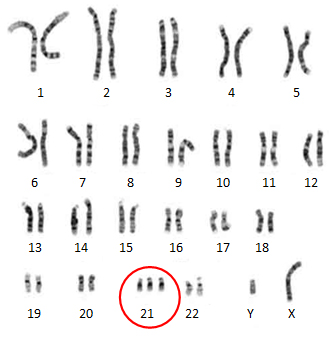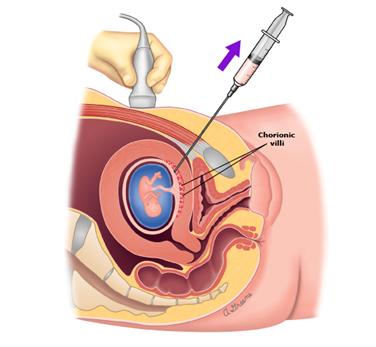What is Chorionic Villus Sampling?
Chorionic villus sampling (CVS) is a prenatal test performed during pregnancy to determine if an unborn child is at risk for chromosomal defects.
Tiny finger-like projections on the placenta called the chorionic villi are taken and sent to the lab for genetic analysis. During pregnancy, the placenta provides oxygen and nutrients to the growing baby and removes waste products from the baby's blood. The chorionic villi are wispy projections of placental tissue that share the baby's genetic makeup.
The sample is taken through the abdominal wall (transabdominal). Chorionic villi can be analysed to identify genetic and chromosomal abnormalities. Because the chorionic villi are of fetal origin, examining them can give a clear picture of the genetic makeup of the developing fetus, including Down syndrome (or trisomy 21), Patau syndrome (trisomy 13), Edward’s syndrome (trisomy 18), triploidy and other genetic disorders. CVS cannot, however, test for neural tube and other anatomical defects.
The test produces a karyotype – a picture of the baby's chromosomes – which provides detailed information on any abnormality.

Women who choose to have CVS are often those at increased risk for genetic and chromosomal problems. The test is invasive and carries a small risk of miscarriage.
CVS is usually done between weeks 11 and 13 of pregnancy — earlier than other prenatal diagnostic tests, such as amniocentesis (where the patient has to be at least 16 weeks pregnant).
When is it considered?
CVS is offered only if there's a high risk that the baby could have a genetic or chromosomal condition.
This could be because:
- A pregnancy screening test has suggested there may be a problem, such as Down syndrome, Edward’s syndrome or Patau syndrome.
- The mother has had a previous pregnancy with the above mentioned chromosomal problems.
- The patient has a family history of a genetic condition, such as thalassaemia, cystic fibrosis or muscular dystrophy, and/or an abnormality is detected in the baby during a routine ultrasound scan. The patient is over 37 years of age, since women over 37 are at higher risk of having children with chromosomal abnormalities
- The patient or her partner has a genetic disorder
- The patient or her partner has a family history of a genetic disorder
- The patient has other children with genetic or biochemical disorders
It's important to remember that the patient does not have to have CVS just because it's recommended. It's up to the patient to decide whether she wants it based on the information / counselling provided by the Fetal Medicine specialist. The test can detect more than 200 different types of genetic and biochemical conditions. Performing the test early on during the pregnancy gives parents the information they need to cope with some of the complications of the pregnancy, or the possibility of terminating the pregnancy.
How is the procedure performed?
The main goal of CVS is to obtain a tiny tissue sample from the placenta, which will be sent to a lab for analysis. The sample will be extracted through the abdomen (transabdominal).Ultrasound will be used to help the doctor guide the needle to the placenta. Gel will be rubbed on the abdomen and a local anaesthetic is administered at the procedure site. An ultrasound device will be moved over the abdomen and will give off / pick up sound waves. The sound waves are used to make a picture of the uterus, the baby, and the placenta on a screen. The doctor can also use ultrasound to check the baby's heart rate. The doctor then puts a long, thin needle through the abdominal wall and uterus to the placenta. The needle is used to collect a sample of the chorionic villus cells.
After the sample is collected, the doctor may listen to the baby's heartbeat.
Before the procedure, the patient will have an ultrasound to confirm how far along the pregnancy she is and to make sure it's possible to get a good sample for the test.
During the procedure, the amniotic sac where the baby is growing won't be disturbed. The procedure takes about 20 to 30 minutes from start to finish and the extraction itself takes only a few minutes. Some patients may experience some pain or discomfort in the abdominal area.

What kind of problems does CVS diagnose?
CVS can identify:
- Nearly all chromosomal abnormalities, including Down syndrome, Trisomy 13, Trisomy 18, and sex chromosome abnormalities (such as Turner syndrome). The test can diagnose these conditions, but it can't measure their severity.
- Several hundred genetic disorders. The test is not used to look for all of them, but if the baby is at increased risk for any particular genetic condition, CVS can usually tell whether the baby has the disease.
- It should be noted that in case of CVS, there's a 1 to 2 percent chance of getting an unclear result. This is called a confined placental mosaicism, in which some of the cell lines cultured from the placenta contain abnormal chromosomes and some are normal. If the CVS detects a mosaicism, the patient will have to have amniocentesis and possibly other testing to determine whether the baby is affected.
What factors would put the patient at higher risk of having a baby with a genetic abnormality or disorder?
Some factors to consider include:
Down syndrome screening results: The patient had a first trimester screening or nuchal translucency screening that indicated that the baby is at a higher risk for Down syndrome or another chromosomal problem.
Ultrasound results: An early ultrasound showed that the baby may have structural defects associated with a chromosomal problem.
Carrier screening results: The patient and her partner are both carriers of a recessive genetic disorder.
Patient’s history: The patient previously has been pregnant with a child with a genetic abnormality and may be at a higher risk of this happening again.
Family history: The patient or her partner has a chromosomal abnormality or genetic disorder or a family history that puts thechild at increased risk for genetic problems.
Age: Anyone can have a baby with a chromosomal abnormality, but the risk rises with the mother's age. For example, the likelihood of carrying a baby with Down syndrome ranges from about 1 in 1,200 at age 25 to 1 in 100 at age 40.
What are the risks of CVS?
Some of the risks involved with the procedure include:
Bleeding and cramping - The patient may experience cramping or bleeding. CVS may cause cramping, leakage of amniotic fluid, and vaginal spotting. These will go away in 1 to 2 days.
Infection - As with any invasive procedure, there is a risk of infection, though this complication occurs rarely.
Rh sensitization - During the procedure, there’s a chance that the baby’s blood may be mixed with the mother’s blood. If the patient has Rh-negative blood and the baby is Rh-positive, the patient may become sensitized. This will cause the patient’s body to produce antibodies that attack the baby’s blood cells. If this occurs, the doctor can give a medication called Rh immune globulin. This medication will stop the patient from becoming sensitized. If the patient is Rh-negative, the doctor must be informed.
Accidental abortion or miscarriage - it's estimated to be between one in 100 and one in 200
CVS also increases the risk of Infection in the uterus.
The patient is advised to call the doctor in case of,
- Moderate or severe abdominal pain or cramping.
- More leakage of amniotic fluid from your vagina.
- More vaginal bleeding than spotting or bright red bleeding.
- Chills or a fever.
- Dizziness.
- Redness or swelling at the needle site if you had an abdominal procedure
The patient should discuss the risks and benefits of the test with the obstetrician. Even though the doctor may recommend the test, the decision to undergo the procedure is entirely up to the patient and her family.
Factors to consider when deciding between CVS and amniocentesis?
Both tests can tell whether the baby has a chromosomal problem or certain genetic disorders. CVS is done earlier in pregnancy (usually between 11 and 13 weeks), so the doctor can find out sooner about the baby's condition. If there is a serious problem and the patient opts to terminate the pregnancy, she’ll be able to do so while still in the first trimester.
On the other hand, the patient may prefer to wait for the results from second-trimester screening before subjecting herself to an invasive test. At that point, amniocentesis would be the only option.
